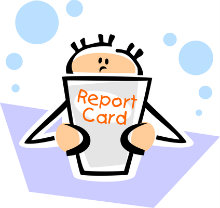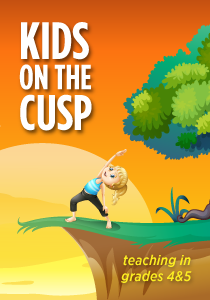Report Cards: Theirs & Mine
A MiddleWeb Blog
It’s report card time. One thing I truly dislike about teaching is the responsibility of doling out grades – specific letters that indicate levels of success for kids. The path toward authentic assessment is mired by the use of report cards based on traditional assessment practices. My students often attach grades to self-worth.
I have seen the faces of kids who receive a test with a poor grade on it, students who question the “minus” on the A- they earned. They judge themselves quite harshly at times. Helping children feel successful is a daunting task when I find myself looking into a set of disappointed eyes.
My district uses a letter scale, A through F, based on cumulative grades, weighted evaluation criteria, and calculated averages. Sub-categories identify more explicit information about academic benchmarks and social-emotional growth.
Explicit is a word with many meanings, one of which is the word clear. Clarity is something lacking in the world of report cards and what they truly signify. Why do we use traditional report cards when our goal is authentic assessment. Unambiguous is also considered to be a synonym for explicit. There certainly is an inherent ambiguity in it all.
Assessing THEM

Scoring writing is a more complex task. It’s subjective. There is no answer key. The development and use of specific writing rubrics eases the task by breaking down student writing into smaller pieces. Mechanics is pretty cut and dried. Sentence structure and punctuation are rule-based. Content and the development of ideas get a bit tricky.
Rubrics help me get a number grade. They help me report individual student progress in statistical form, reflected by one of the first six letters of the alphabet (excluding E, whose omission in this alphabetical grading system has eluded me thus far in my teaching career).
Rubrics can serve as a guide, but ultimately, I am responsible for my own version of subjective and ambiguous, and thus, the fate of my students on report card day.
Assessing ME
As I continue to self-assess using the New Jersey teaching self-assessment tool (my own, state-mandated teacher report card), I need to use rubrics as a means for reflection and growth. This is a practice I try to develop in my students to help them assess their own progress and set their own intrinsic goals.
Let’s leave the numeric rating out of the conversation for this next domain in Kim Marshall’s state-adopted rubric. A healthy balance of traditional and authentic assessments is needed when it comes to assessing my students. Taking a more informal, reflective look at my performance may be more “Effective” than focusing on the number at the top of my state report card, too.
Domain D: Monitoring, Assessment, and Follow-Up
(a) Criteria asks us to identify explicitly what is deemed to be acceptable student work. Clear expectations must be set. Students need examples of what represents achievement of goals. Rubrics are useful in identifying these criteria, and in helping students develop the tools they need to accurately self-assess.
(b) Diagnosis looks at how well we pre-assess as a tool to guide instruction. A child’s ability to memorize math facts and apply mathematical algorithms is easy to pre-assess. A child’s ability to read and interpret text, or their ability to use expressive language, is a bit harder to diagnose. It takes individual, one-on-one teacher time to get a true analysis of each student’s specific strengths and weaknesses. Finding this time is one of my greatest challenges as an educator. It often feels like a triage situation, based on degrees of urgency, especially when you’re vastly outnumbered, and time is of the essence.
(c) On-the-spot, being observant of what’s happening with each lesson, calls for quick decision-making. Extending a lesson for the good of embracing those teachable moments challenges us to use our time well. Cutting an ineffective lesson off at the knees, picking us up, dusting us off, and trying a different approach are needed as well. Putting on the brakes until I can figure out how to remedy their lack of understanding (or my level of “Ineffective” at that particular moment) is crucial to our mutual success.
(d) Self-Assessment is the art of asking students to set their own goals and accurately assess their strengths and weaknesses. I’ll be 47 next month, and I still have difficulty with this one in my own life. I can’t expect them to have mastered it at their age. Encouraging students to be reflective of their progress and thoughtful of their mistakes moves us away from negative self-judgment and toward a more positive, goal-oriented attitude as learners.
(e) Recognition is a category that asks how we post student work. I don’t post graded work (okay, I don’t post graded work with the grades clearly visible). Public opinion can lead us back to negative self-worth.
(f) Interims are a tool that effective teachers use to “adjust teaching, re-teach, and follow up with failing students.” I don’t like the word failing, but I get the gist of this category. I use interims to do this. There isn’t enough time to complete interims in between interims in any official way. So in between interims I rely on more subjective assessment techniques. Simply said, I try to pay attention to what’s going on with each student and adjust my teaching accordingly.
(g) Tenacity is a great word. I Googled synonyms and found the following list: persistence, determination, perseverance, tirelessness, firmness, patience, steadfastness, endurance, stamina, stubbornness. Many of these qualities can be considered strengths. Many can be seen as weaknesses (this is in direct proportion to my ability to accurately self-assess).
(h) Support focuses on special needs students. Marshall’s rubric requires that I “make sure all students who need specialized diagnosis and help receive appropriate services immediately.” The only glitch in this is that often this decision is not up to me. I’m tenacious (see above), but that doesn’t mean each child gets what they need.
(i) Analysis, or over-analysis as the case may be, directs us to ask ourselves how well we work with colleagues to analyze data and develop best practices. Most of my team’s collaboration happens by the copy machine or during brief classroom visits to share something that worked well for us or to vent frustrations. I would certainly like more time to collaborate, but we don’t have too many half-day training schedules in the budget, so we need to make do with what we have. Sometimes our goals and reality just seem to be walking on different paths, muddied or not.
(j) Reflection is the key. Highly effective educators work with colleagues to “reflect on what worked and what didn’t” in an effort to continuously improve instruction. (See “Analysis.”)
Regardless of the number assigned to my effectiveness as an educator, I hope I can transmit the habit of meaningful and useful self-reflection to my students — ideally by next Monday, when report cards go home.





































